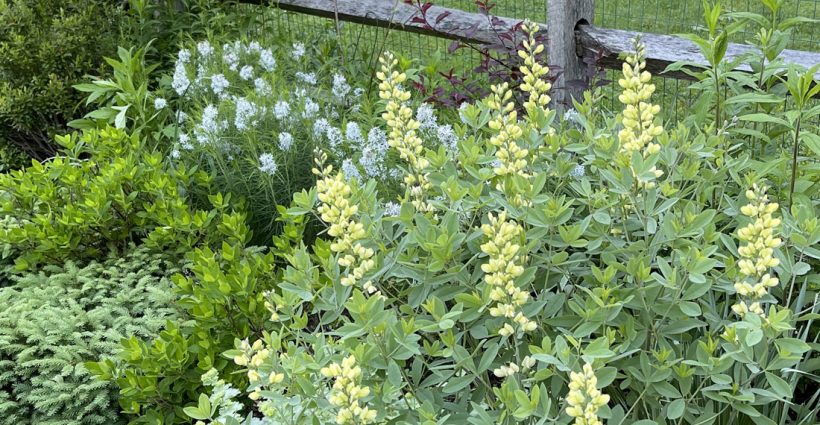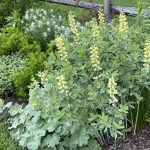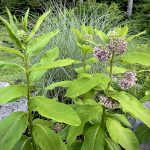designed for the way women work.

Moving and Dividing Perennials That Don’t Want Their Root Systems Disturbed by Jeannette Ross
Category: 'Dear Ruth' Column, Flower Gardens, Plant Ideas & Info, Presenting "The Curious Gardener"
For some perennials, it is especially difficult to move or divide them. You plant them, they thrive, then you decide to uproot them and they just don’t want to go there.
Perennials that would just as soon be left alone include Baptisia, lupine, Oriental poppy, milkweed, Russian sage, goatsbeard, red hot poker, and peony.
To learn ways to increase your success, our go-to horticulturist Ruth Clausen provides tips. When you move them and how you do it is critical.
- Learn when the optimal time to move a particular plant is, whether spring, fall, or even summer.
- Dig a hole of adequate size for the roots to spread. Depth and width are important.
- When digging up your plant, try not to disturb roots by digging as wide and deep as you can. Using a pitchfork can help prevent breaking roots.
- After digging up your plant, be sure to protect it from drying out. Don’t knock off all the soil surrounding the roots, as it will move to the new hole with the plant, and cover roots with a light colored or white cloth.
- Be sure the soil in the new hole is nutrient rich and porous enough for the new plant.
- If the plant you are moving has a crown, build a little mound in the center of the hole so the roots can drape over it. When your plant is in place, tamp down the soil with your feet, eliminating air pockets that can dry out roots.
Here are some of the top finicky perennials when it comes to disturbing their roots, and how to move them.
Baptisia (shown here), with its deep taproot, has a deserved reputation for being difficult to move or divide, and most gardening references will advise leaving it alone, cutting it back in spring if it is spreading beyond its intended space. According to Ruth Clausen, Baptisia can be transplanted with care. The same goes for lupine (Lupinus), which also has a long fleshy taproot, both plants being members of the pea family (fabaceae).

When preparing to move or divide either of these plants, the first step is to make sure your soil is in good condition and then dig a large hole. When moving the plant, dig as far around it as possible. Get as much of the root as you can, but you will likely have to break it. Cover the transplant with fabric, and be sure to water it generously once put back in the ground. Even though these plants tolerate dry conditions when established, do not let them dry out during this important stage! The best time to do this is in mid-summer, when flowering has died down.
Oriental poppies (Papaver orientale) should not be moved when they are actively growing. Wait until they are dormant in early summer after the tops die to the ground. Because of their long taproot, be sure to dig deep and keep the soil around the root as intact as possible. Place it gently into its new hole, which you have dug equally deep and wide.
New poppy plants can be started from four-to-six-inch root cuttings of dormant plants taken in mid-to late summer.

Milkweed (Asclepias ) was once considered a weed but now is prized as being pollinator-friendly, particularly for monarch butterflies. Some varieties can be dug up by the rhizome (root) and replanted, including the common milkweed (Asclepias syriaca) This works best when plants are small and temperatures are cool. However, a deep taproot makes things more challenging.
Once again, attempt this in spring when shoots are small. Prepare a hole, dampen and amend with compost, if needed. When digging a plant, dig about four inches out, around all sides to avoid cutting and wounding the taproot. Dig as deep as you can to avoid damage. Retain as much soil on the rhizome as possible. After planting, make sure the soil stays moist for a few weeks to encourage root growth. Fertilizer can be added but only after the plants put out new growth.
Russian sage (Perovskia atriplicifolia) is another popular plant that grows from a rhizome. Native to central Asia, it can tolerate hot and dry conditions.
The soil in the hole you dig for your plant’s new location must be loose to encourage good drainage. Adding compost can help with this. Using a garden fork, dig about one foot out from the plant’s central stem and slowly work the root ball out of the soil. Replant right away to minimize drying out, filling in any gaps around the root ball. Water well regularly while the plant gets reestablished.
Division is best undertaken on a cool, overcast spring day so the roots will not dry out quickly. Have your hole dug and ready, then dig up a clump of the plant that includes at least four or five shoots and shake it gently to remove excess soil. Trim the clump with pruners or shears, leaving about three to four inches intact. Place in the ground and water thoroughly, keeping the soil evenly moist throughout the first season. After the first season, water only as needed. Be patient, Russian sage can be slow to establish its roots, but new plants will eventually grow and live for many years.
Goatsbeard (Aruncus dioicus) makes a short, but dramatic appearance in early summer, and it is especially attractive when planted in a grouping. Perhaps the most difficult aspect of moving or dividing this large plant is dealing with the heavy roots. The best time to do this is spring or fall. After preparing your hole, lift out a large clump of goatsbeard with its rhizomes. You can create smaller clumps by untangling and cutting the roots with a clean, sharp garden tool. Each clump must have at least one node or “eye” that can go in the ground. Place new plants two to three feet apart.
Red Hot Poker (Kniphofia), will keep you waiting two to three years for a new clump to reach a size where it will send up its fiery spikes of tubular flowers.
Division is easiest in spring by digging away offshoots from the main plant. If you are doing this in summer, it is important to cut the stems down to about four to six inches so the plants can focus their energy on root development. A fork is often the easiest tool to use to lift the plants out of the ground and divide the root ball.
The plants can be moved in early summer through late summer or mid-fall to early winter. These times allow for optimal root growth. When digging up a plant to move it, take care not to break the taproot.
Peony (Paeonia) is a beloved plant that can live for generations, flourishing in one spot for decades. Although many sources discourage attempts to move or divide them, sometimes it’s done for their own good. For instance, if over time other plants, including trees, grow up around them and block their sun it’s time to find a new location for them.
The best time to move peonies is late summer or early fall after plants have stored adequate food sources in their roots for the following year.
When moving peonies, take care with the long, slender roots and the bright pink buds or ‘eyes’. Plant the roots so the tips of the buds are no more than two inches below the surface of the soil. Planting any deeper will discourage blooming.
When moving or dividing, begin by digging a hole in a sunny location with good drainage large enough to accommodate the root system of the new plant. Before moving cut peony stems near the ground, then dig up the plant and gently shake off excess soil. To divide them, take your sharp knife and cut the clump into sections that each have three to five buds and a good root system. After placing in the hole and firming the soil, water thoroughly. Space your new plants three to four feet apart to give them plenty of room to spread.
Be patient. Peonies usually take three to five years to grow to maturity and there may be no blossoms the first year and only a few the next, but you will eventually be rewarded with gorgeous, fragrant blooms.
If you’ve had difficulty moving other perennials, tell us about it. This list is not intended to be comprehensive.



Is one type of insect repellent better than another? For example, powder Slevin vs spray Slevin? A few of my perennials have been ravaged by white flies and other microscopic insects!